12 Best No-Code AI Platforms to Watch in 2025
Discover the top 12 no-code AI platforms for 2025. Compare features, pricing, and use cases to build AI solutions without writing a single line of code.

Artificial intelligence is no longer restricted to developers with years of coding experience. A new generation of tools lets you build, train, and deploy powerful AI models using simple visual interfaces. These no-code AI platforms make it possible for marketers, analysts, and entrepreneurs to create everything from customer churn predictors to automated content classifiers.
This guide breaks down the top 12 platforms available today. We will look at their specific strengths, ideal use cases, and what to consider before you commit. The goal is to give you a clear map for finding the right tool for your specific project, team size, and technical comfort level.
We will cover a range of options, from tools designed for specific tasks like analyzing customer feedback to enterprise-grade systems for building complex predictive models. Each entry includes screenshots, direct links, and an analysis of its core features to help you compare your options efficiently. You will find out which platforms are best suited for product teams wanting to test new features, marketing teams aiming to personalize campaigns, or agencies looking to scale their services without hiring a data science team.
The practical applications for this technology are already producing significant results for businesses. To see a real-world example, you can read about how Popsips uses influencer gifting and AI to seed products at scale, demonstrating how accessible AI is being used for tangible outcomes. Our list will provide the insights you need to select a platform and start building your own AI-powered solutions.
1. Surva.ai
Surva.ai establishes itself as a premier choice among no-code AI platforms by offering a highly specialized solution for a critical business challenge: customer retention. Designed specifically for SaaS companies, this platform moves beyond simple survey creation. It provides an intelligent, automated system for understanding and acting on user feedback to actively reduce churn. Its core strength lies in translating qualitative feedback into quantitative, actionable insights that product, marketing, and customer success teams can use immediately.

What truly distinguishes Surva.ai is its proactive approach to churn deflection. Instead of just gathering data on why a customer is leaving, the platform’s intelligent workflows can trigger real-time, personalized interventions. For example, if a user cites "price" as their reason for cancellation, the system can automatically present a pre-configured discount offer. This direct, automated engagement at a pivotal moment is a powerful tool for retaining otherwise lost revenue.
Key Capabilities and Use Cases
- Intelligent Churn Deflection: Deploy automated surveys within your cancellation flow. Based on user responses, the platform can trigger personalized offers like subscription pauses, plan downgrades, or direct calls with customer support, effectively saving customers on the spot.
- AI-Powered Insight Analysis: The platform's AI analyzes open-ended feedback from surveys, identifying recurring themes, sentiment, and critical issues. This saves teams countless hours of manual analysis and highlights the most impactful areas for product improvement.
- Automated Testimonial Collection: Easily gather social proof by setting up workflows that request testimonials from satisfied customers. These can then be used to strengthen marketing materials and build brand credibility.
- Seamless Integrations: Surva.ai connects directly with important SaaS tools like Stripe, Gmail, and Slack. This integration allows for a unified workflow, helping teams receive instant notifications and manage feedback without disrupting their existing processes. You can learn more about how Surva.ai operates as a no-code AI platform on their blog.
Platform Analysis
Website: https://www.surva.ai
2. Google Cloud Vertex AI
Google Cloud Vertex AI is a unified machine learning platform that brings together Google's existing AI and ML services into a single, cohesive environment. It stands out by offering a complete, end-to-end workflow for both technical and non-technical teams. Users can manage everything from data ingestion and preparation to model training, evaluation, and deployment without ever leaving the Google Cloud console, making it one of the most integrated no-code AI platforms available.
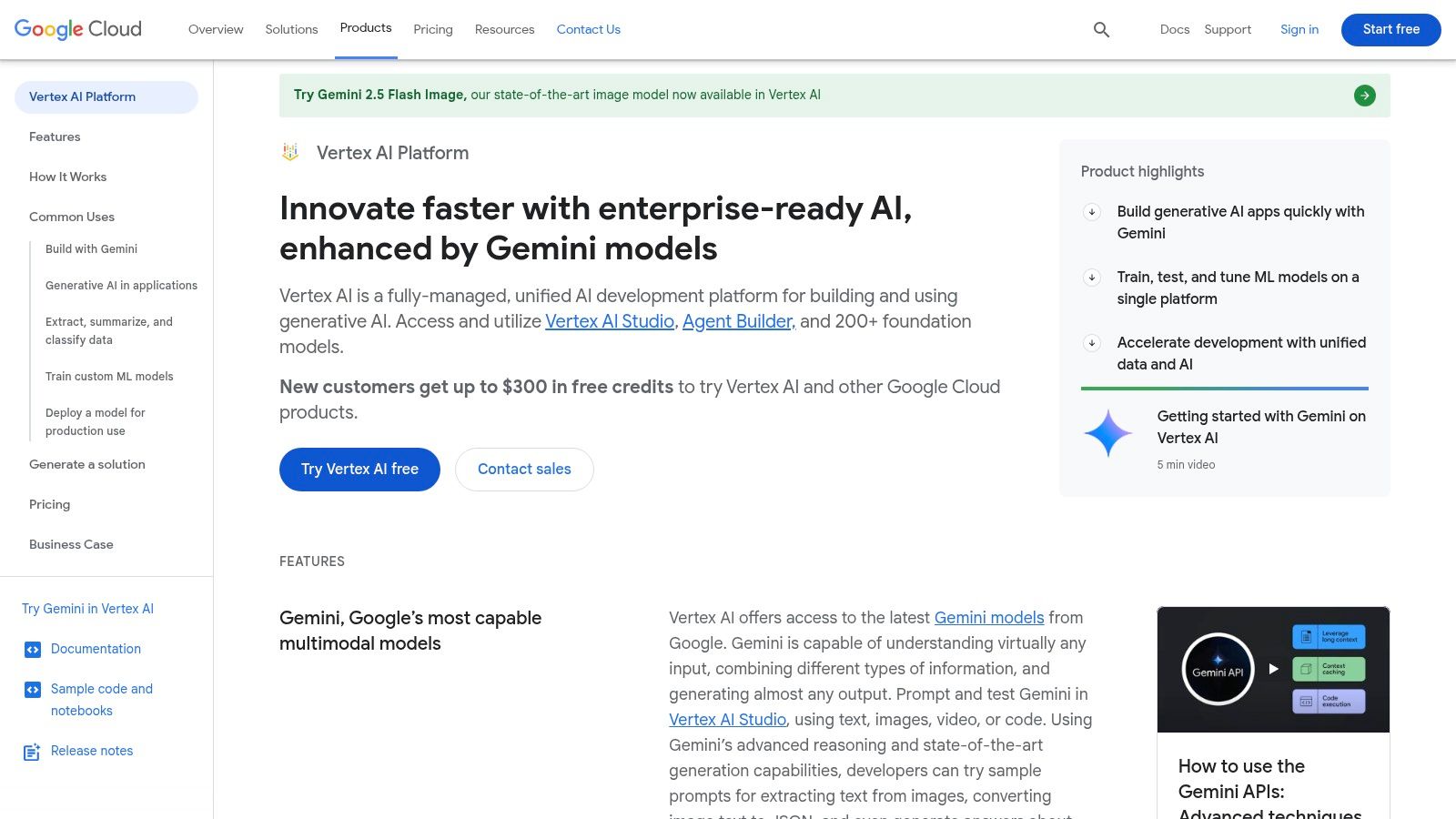
The platform’s strength lies in its AutoML capabilities and the intuitive Vertex AI Studio. With AutoML, you can use a graphical interface to build high-quality custom models for tabular data, images, and text with minimal ML expertise. For generative AI tasks, Vertex AI Studio provides a point-and-click interface for designing prompts, grounding models with your own data, and evaluating responses from Google's Gemini models.
Key Features and Considerations
The platform is built on Google's secure and compliant infrastructure, which is a major advantage for organizations with strict data governance requirements.
- Best For: Teams already invested in the Google Cloud ecosystem, especially those using BigQuery or Looker, who need a managed, scalable solution for building and deploying production-grade AI models.
- Pricing: The cost model is complex, with charges based on tokens, characters, or instance hours depending on the service. A Google Cloud billing account is required, but new users can often access a $300 credit to get started.
- End-to-end MLOps solution in a single console.
- Leverages Google Cloud's enterprise-grade security.
- Transparent pricing for the latest Gemini models.
- The multifaceted pricing structure can be difficult to predict.
- Requires setup within the broader Google Cloud Platform.
Visit the website: https://cloud.google.com/vertex-ai
3. Microsoft Power Apps + AI Builder
Microsoft Power Apps, combined with its AI Builder component, allows users to embed AI directly into business applications with minimal technical knowledge. This platform shines within the Microsoft ecosystem, enabling teams to improve new or existing apps with pre-built or custom AI models. Users can implement features like document processing, prediction, and object detection using a familiar drag-and-drop interface and Power Fx formulas, making it one of the most accessible no-code AI platforms for business process automation.
The platform’s core strength is its native integration with Microsoft 365, Teams, and Dataverse, which simplifies the process of connecting AI capabilities to existing business data and workflows. AI Builder provides a library of ready-to-use models for tasks like form processing and text analytics, while also allowing you to train custom models suited to your specific needs. For a more detailed look at its capabilities, you can find a comprehensive guide on building with Microsoft Power Apps + AI Builder.
Key Features and Considerations
The AI Builder component operates on a credit-based system, which offers flexibility for organizations to scale their AI usage based on actual demand and business cycles.
- Best For: Organizations already using Microsoft 365, Dynamics 365, or the Power Platform who want to quickly add AI features to their internal business applications.
- Pricing: AI Builder is priced per unit/month, with each unit providing 1 million AI Builder credits. A Power Apps license is required to use it, and some plans include a starting capacity of credits.
- Seamless integration with the Microsoft 365 and Power Platform suite.
- Easy no-code embedding of AI into functional business apps.
- Scalable, credit-based model for predictable AI spending.
- The licensing and credit system can be confusing at first.
- Provides the most value when kept within the Microsoft ecosystem.
Visit the website: https://powerapps.microsoft.com/ai-builder
4. Amazon SageMaker Canvas
Amazon SageMaker Canvas is AWS's visual, point-and-click service that allows business analysts to generate accurate machine learning predictions on their own, without writing any code. It extends the power of Amazon SageMaker to users who may not have deep technical expertise. The platform provides a guided workflow for preparing data, automatically building and training models, and generating insights, positioning it as one of the most accessible enterprise-grade no-code AI platforms.
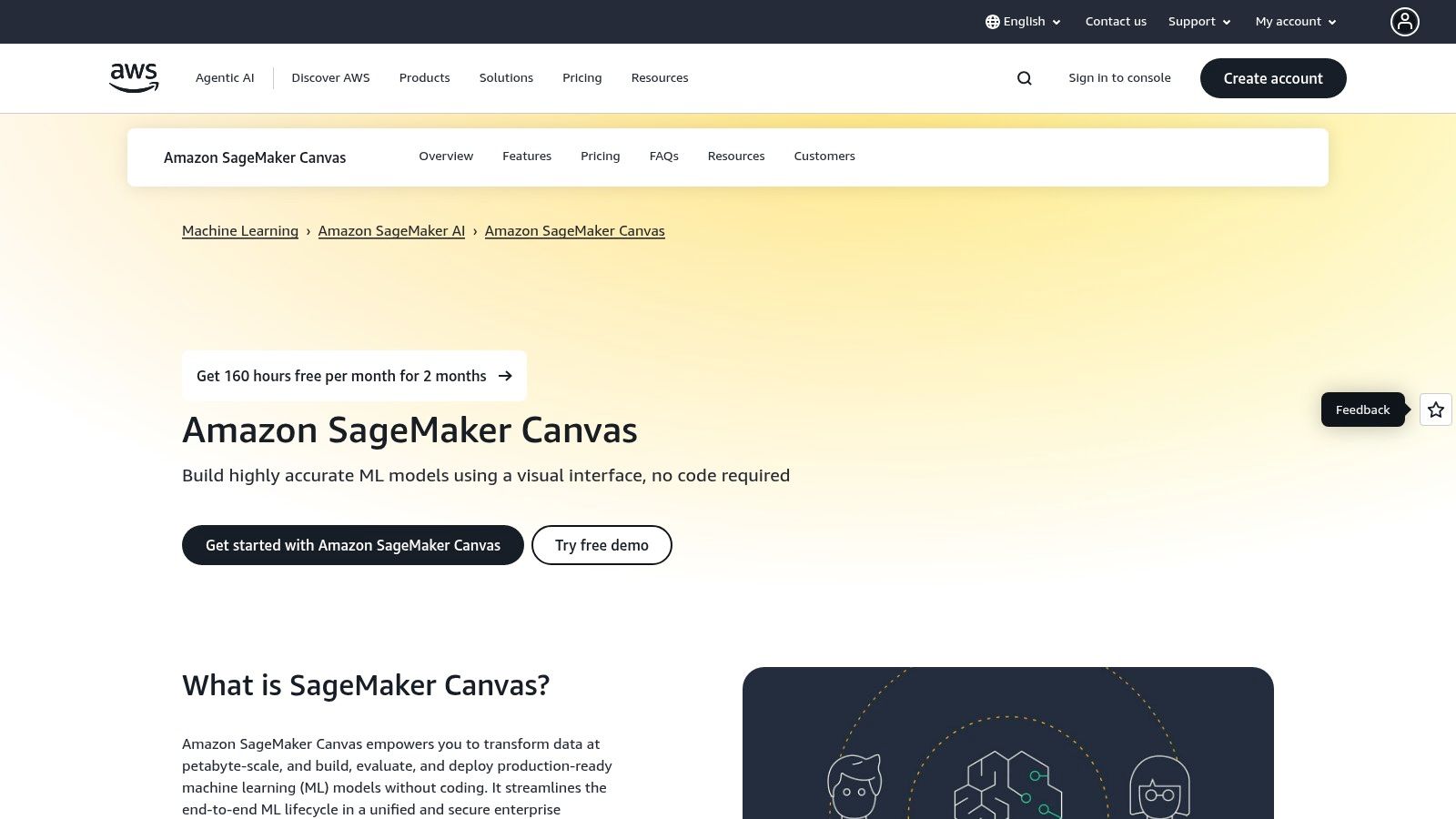
The platform’s standout feature is its ability to bridge the gap between business teams and data scientists. Analysts can create and experiment with models, and then share those models with data science teams via SageMaker Studio for validation or deeper collaboration. This integration also allows users to access pre-trained models for tasks like document analysis or image recognition directly within the Canvas interface, simplifying common business use cases.
Key Features and Considerations
Built on the robust AWS infrastructure, SageMaker Canvas benefits from the same security, governance, and scalability that powers the rest of the AWS ecosystem.
- Best For: Business users and analysts working within an AWS environment who need to quickly build predictive models for tasks like forecasting, customer churn analysis, or fraud detection without coding.
- Pricing: Canvas uses session-based pricing, charging for the time the application is active. Costs also depend on the underlying AWS services used for data processing and model training, which can make the total price difficult to forecast.
- Seamlessly integrates with the entire AWS ecosystem.
- Promotes collaboration between business and technical teams.
- Strong enterprise-grade security and governance features.
- Session-based pricing can lead to unexpected costs if users forget to log out.
- The cost structure involves multiple AWS services and can be complex.
Visit the website: https://aws.amazon.com/sagemaker/canvas
5. IBM watsonx.ai (Studio)
IBM watsonx.ai is an enterprise-focused studio for building, training, and deploying AI models with a strong emphasis on governance and trust. It provides a collaborative environment where both technical and non-technical users can access prompt engineering tools, machine learning workflows, and pre-built models. The platform stands out by integrating IBM's proprietary Granite models alongside popular third-party foundation models, all within a framework designed for enterprise-grade security and compliance, making it one of the more robust no-code AI platforms for large organizations.
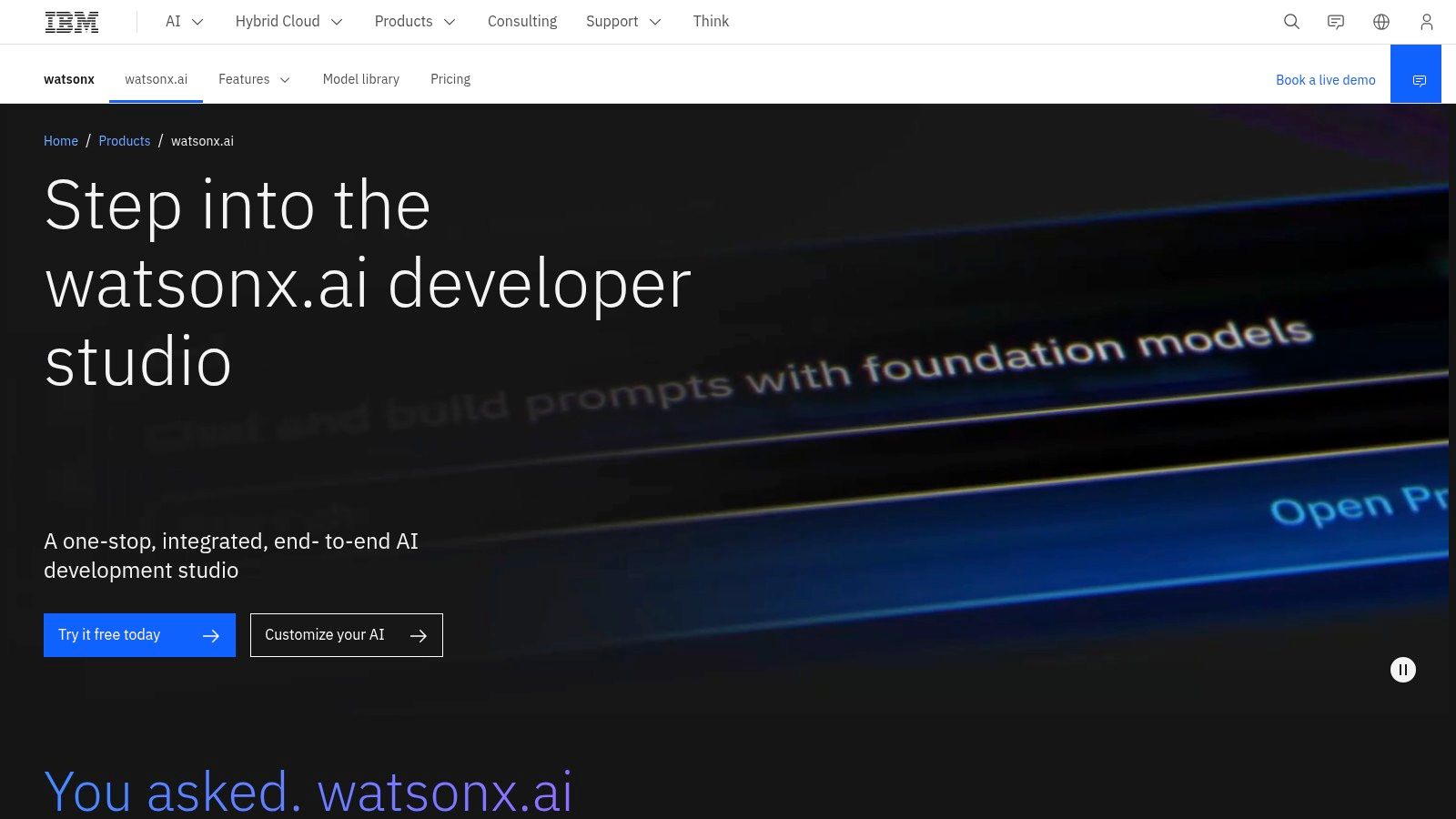
The platform's core is the watsonx.ai Studio, which offers a playground UI for experimenting with generative AI prompts, building AI agents, and leveraging machine learning tools. Users can work with foundation models for tasks like text generation and summarization or use specialized tools for text extraction and data analysis. This integrated approach allows teams to manage the entire AI lifecycle, from data preparation to model deployment and monitoring, while adhering to strict governance protocols.
Key Features and Considerations
A key advantage for regulated industries is the platform's commitment to enterprise compliance, including options for FedRAMP, which is important for government contractors.
- Best For: Large enterprises, particularly in regulated industries like finance and healthcare, that need a governed, secure, and scalable environment for developing and deploying trustworthy AI.
- Pricing: A mix of capacity-unit pricing for studio tools and transparent per-token pricing for foundation models. The detailed structure is built for enterprise consumption.
- Robust focus on enterprise compliance and AI governance.
- Access to IBM Granite and third-party models in one platform.
- Comprehensive toolset for the entire MLOps lifecycle.
- The pricing information is detailed and can be complex to interpret.
- Better suited for large-scale enterprises than for individual developers or small teams.
Visit the website: https://www.ibm.com/products/watsonx-ai
6. DataRobot
DataRobot is an enterprise-focused AI platform designed for building, deploying, and managing both predictive and generative AI applications at scale. It positions itself as a comprehensive solution for organizations that require robust governance and operational efficiency. The platform excels at automating the entire machine learning lifecycle, from data preparation and feature engineering to model deployment and monitoring, making it a powerful choice among no-code AI platforms for large-scale business operations.
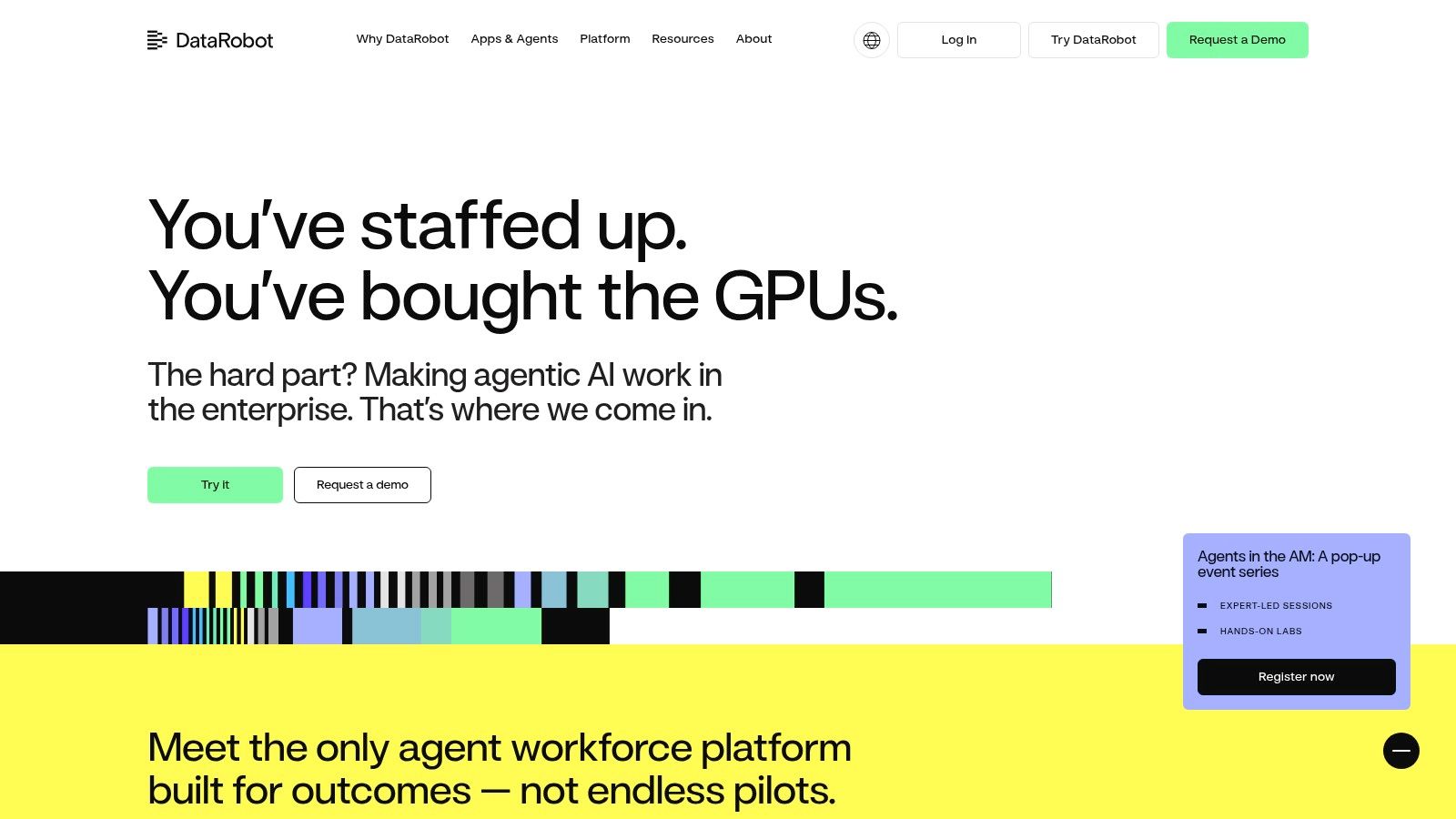
Its core strength is its mature AutoML engine, which automatically builds and ranks hundreds of models based on your dataset, allowing teams to find the optimal solution without deep data science expertise. Recently, DataRobot expanded its offerings to include tools for creating and managing AI agents, which can be integrated into existing enterprise systems to automate complex workflows and improve outcomes. For example, you can see how AI is used to optimize the customer experience.
Key Features and Considerations
The platform provides exceptional MLOps capabilities, making sure that models are monitored for performance, drift, and bias once they are in production, a key requirement for regulated industries.
- Best For: Large enterprises in sectors like finance, healthcare, and retail that need a secure, scalable, and governable platform for deploying mission-critical AI applications across various environments, including cloud and on-premises.
- Pricing: Pricing is not publicly listed and is typically managed through enterprise-level contracts. Prospective users must contact the sales team for a custom quote.
- Mature, enterprise-grade tooling with a strong focus on security and ROI.
- Supports diverse deployment scenarios (multi-cloud, hybrid, on-premises).
- Advanced MLOps and governance features are built-in.
- The platform can be overly complex and expensive for small teams or startups.
- Requires a significant commitment with enterprise-level contracts.
Visit the website: https://www.datarobot.com
7. H2O.ai Driverless AI
H2O.ai Driverless AI is a premier automated machine learning (AutoML) platform that accelerates the data science lifecycle. It shines by automating some of the most challenging aspects of modeling, such as feature engineering, model validation, and hyperparameter tuning. This allows data teams to build highly accurate predictive models in a fraction of the time it would take with traditional methods, positioning it as one of the more powerful no-code AI platforms for enterprise use.
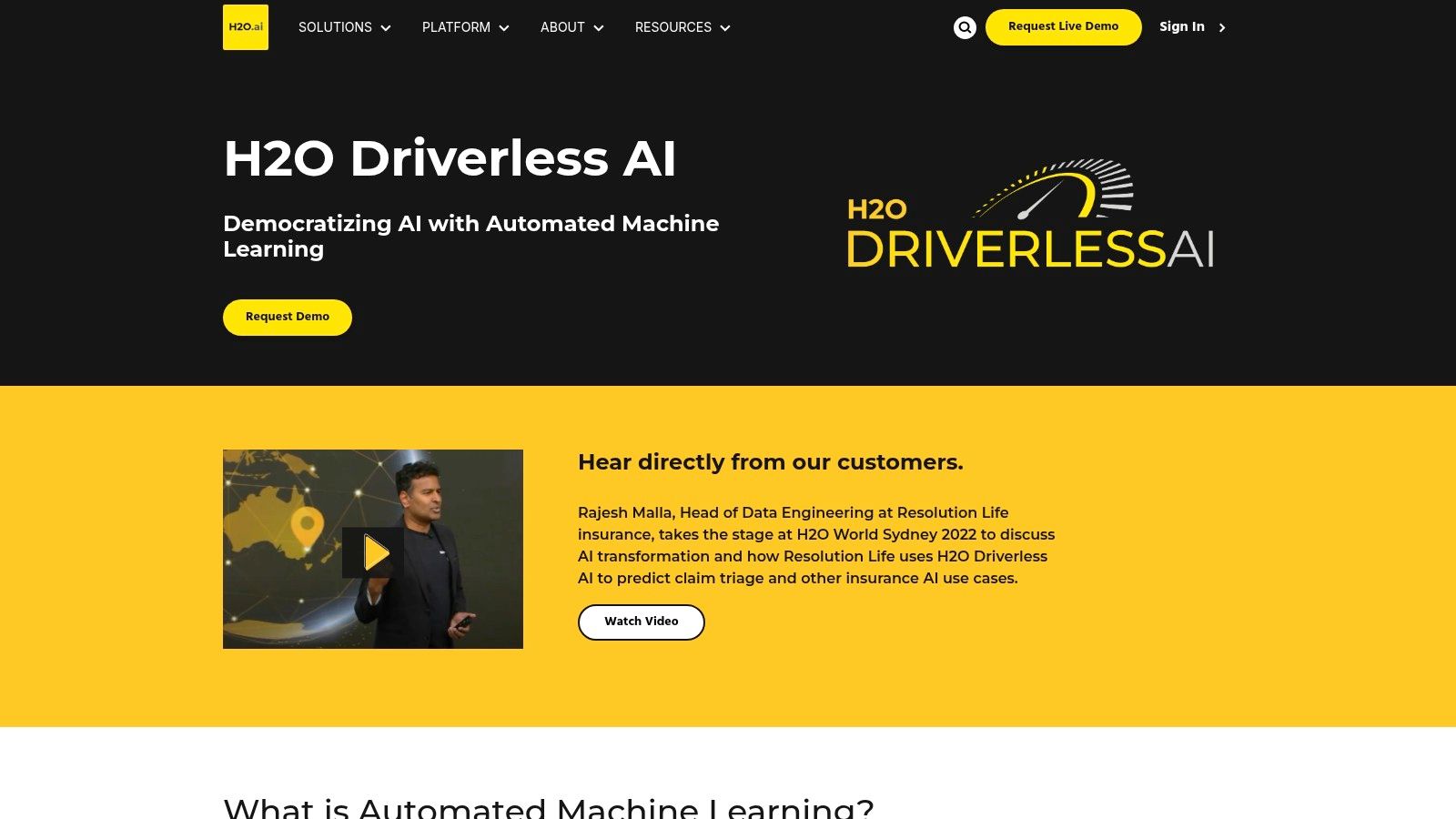
The platform is particularly known for its focus on explainable AI (XAI). It automatically generates visualizations and plain-language explanations for model predictions, making complex algorithms understandable to business stakeholders. With support for advanced analytics like Natural Language Processing (NLP) and time-series forecasting, Driverless AI helps organizations move from raw data to deployed, production-ready models with confidence and transparency.
Key Features and Considerations
A standout feature is AutoDoc, which automatically creates comprehensive documentation for the entire modeling pipeline, which is a major benefit for teams in regulated industries that require detailed audit trails.
- Best For: Data science teams and enterprises in regulated sectors like finance or healthcare that require robust, explainable, and production-ready models with minimal manual coding.
- Pricing: Driverless AI is a commercial product with premium pricing available through a sales team. A free trial is offered to explore its capabilities before committing.
- Strong emphasis on transparency with built-in explainability tools.
- Expert-level automated feature engineering saves significant time.
- Supports advanced use cases including NLP and time-series.
- Commercial licensing can be a significant investment.
- Requires substantial compute resources for training on large datasets.
Visit the website: https://h2o.ai/products/h2o-driverless-ai
8. Dataiku
Dataiku is an enterprise-focused platform designed for "Everyday AI," enabling collaboration across different teams, from data scientists to business analysts. It provides a visual, collaborative environment where users can design, deploy, and manage AI and analytics applications. The platform excels at bridging the gap between technical and non-technical users by offering a unified space for data preparation, model building, and operationalization, making it a powerful choice among no-code AI platforms for large organizations.
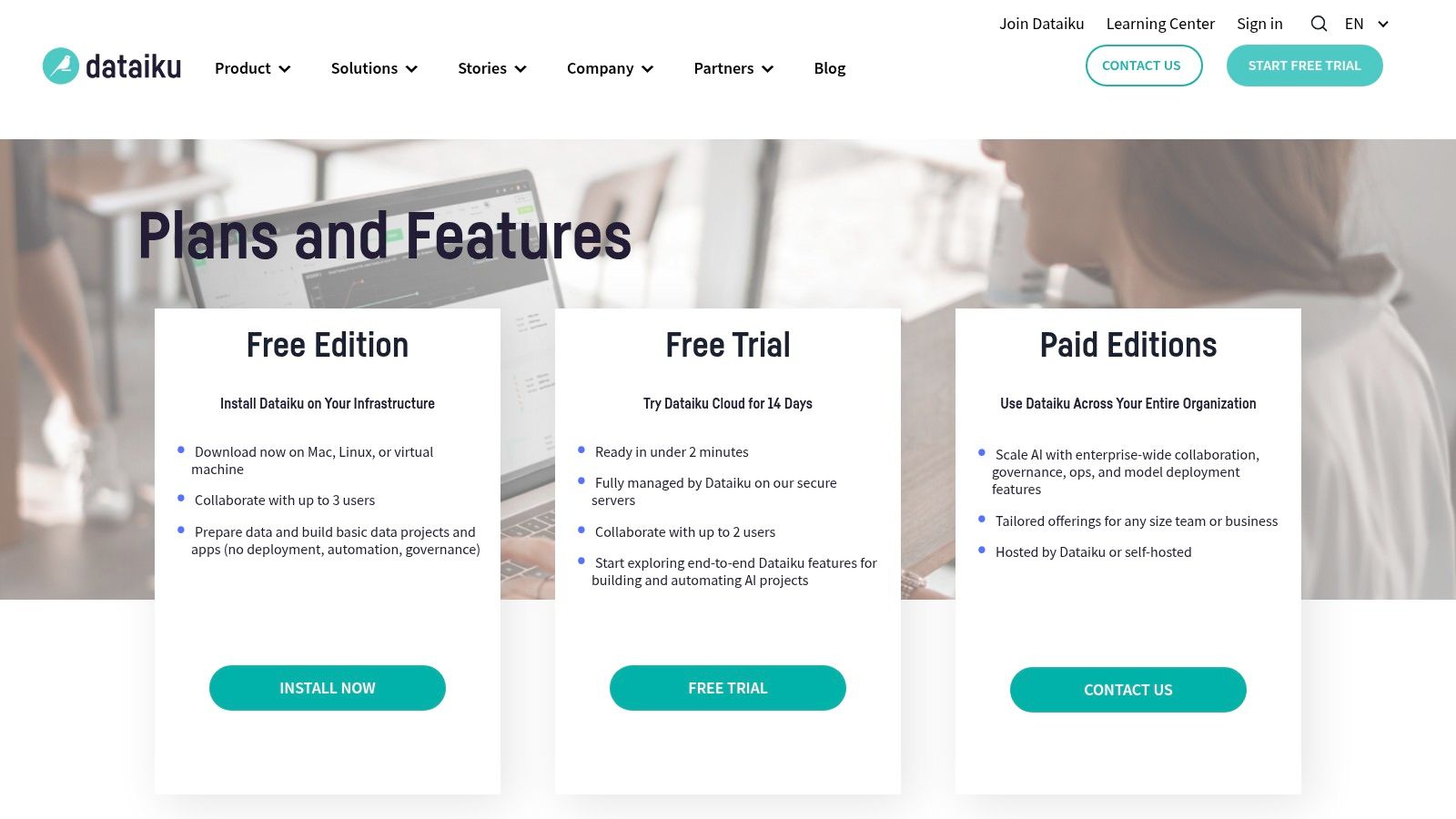
The core of Dataiku is its visual flow, where users can create data pipelines using a drag-and-drop interface. This allows teams to build complex data-to-insight workflows, including data cleaning, feature engineering, and AutoML for model creation. For more customized solutions, the platform includes an App Builder that lets users package AI projects into self-service applications for business stakeholders, complete with interactive dashboards and controls.
Key Features and Considerations
Dataiku is built with enterprise governance and security at its core, offering robust MLOps capabilities for monitoring and managing models in production. This focus on security and scalability makes it a reliable option for regulated industries.
- Best For: Large enterprise teams that require a central, governed platform for data scientists, analysts, and business users to collaborate on building and deploying AI applications at scale.
- Pricing: Pricing is not publicly listed and is suited for enterprise customers. A free trial is available for both cloud and on-premises versions, allowing teams to evaluate the platform.
- Excellent collaboration features for both technical and non-technical users.
- Strong MLOps, governance, and security for enterprise needs.
- Visual pipelines simplify complex data science workflows.
- The platform can have a steep learning curve for advanced features.
- Pricing is enterprise-level and not suitable for small businesses or individuals.
Visit the website: https://www.dataiku.com/product/plans-and-features/
9. Hugging Face AutoTrain
Hugging Face AutoTrain is a powerful tool designed to simplify the process of fine-tuning state-of-the-art machine learning models. It lives within the massive Hugging Face ecosystem, offering a streamlined, no-code interface for training models on custom datasets. This platform makes advanced techniques accessible, allowing users to specialize models for tasks like text classification, image analysis, and more without writing a single line of Python.
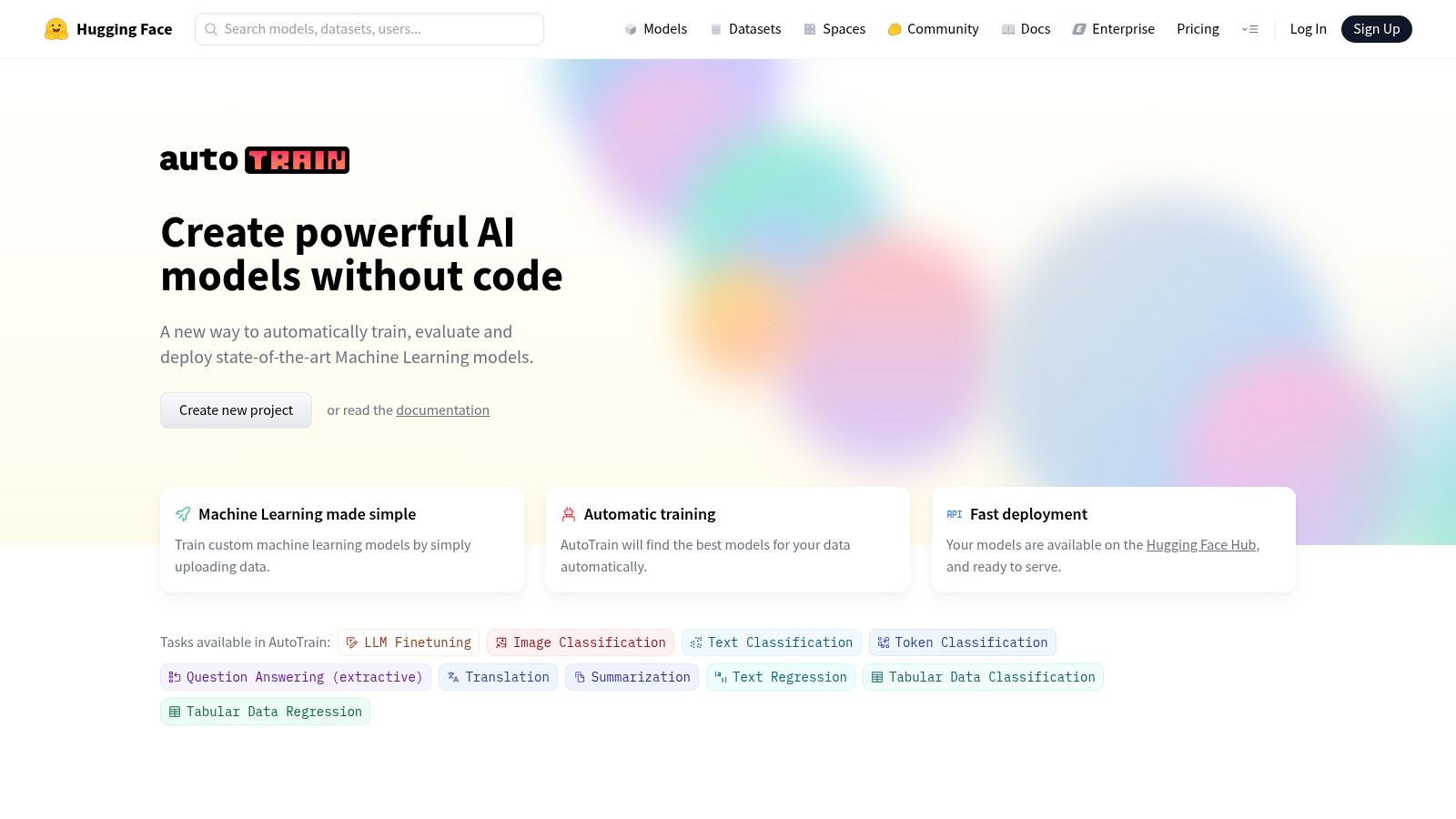
The platform stands out by giving users complete ownership of their trained models, which are automatically saved to their Hugging Face Hub profile for easy sharing and deployment. AutoTrain guides you through selecting a base model, uploading your data, and launching the training job with just a few clicks. It’s one of the best no-code AI platforms for rapid experimentation and creating specialized, open-source models.
Key Features and Considerations
AutoTrain's flexibility allows you to run training jobs locally for free or leverage cloud compute for larger tasks, providing a scalable solution for individuals and teams.
- Best For: Developers, researchers, and product teams who want to quickly fine-tune open-source models on custom data without managing complex training scripts or infrastructure.
- Pricing: Training can be run for free in a local environment or on a Hugging Face Space. For more powerful, managed compute, pricing is pay-as-you-go based on the hardware selected for the training job.
- Extremely fast and simple path from dataset to a fine-tuned model.
- Seamless integration with the Hugging Face Hub and ecosystem.
- You retain full ownership and portability of the models you train.
- Cloud compute costs can be variable and depend on hardware choices.
- Advanced customization options may still require some coding knowledge.
Visit the website: https://huggingface.co/autotrain
10. Akkio
Akkio is an AI analytics platform specifically designed for media and marketing teams. It offers a suite of tools that allows non-technical users to build and deploy predictive models using a natural language interface. The platform's core focus is on practical, high-impact marketing use cases, such as forecasting results, building target audiences, and generating automated reports, positioning it as one of the most specialized no-code AI platforms for the marketing vertical.
The platform stands out with its conversational analytics features, like Chat Data Prep and Chat Explore, which let users clean data and find insights by simply asking questions. Akkio also provides pre-built AI agents for common tasks like audience segmentation and campaign strategy. These agents connect directly to common advertising and marketing data sources, enabling users to get from data to actionable insights quickly.
Key Features and Considerations
Akkio’s primary advantage is its accessibility and rapid time-to-value for marketers who need predictive power without a data science background. The verticalized workflows mean users can solve specific business problems right away.
- Best For: Media agencies, marketing analysts, and growth teams who need to make data-driven decisions about ad spend, customer segmentation, and campaign forecasting without writing code.
- Pricing: Pricing is primarily enterprise-focused and sales-led. Prospective users need to contact the sales team for a custom quote, which is common for platforms targeting agency and enterprise clients.
- Extremely approachable for non-technical marketers and analysts.
- Fast implementation with pre-built, vertical-specific AI agents.
- Strong integration with key marketing data sources.
- Niche focus may not suit general-purpose AI needs.
- Pricing requires a sales inquiry and is not publicly listed.
Visit the website: https://www.akkio.com
11. MonkeyLearn
MonkeyLearn is a dedicated text analysis platform that helps businesses extract actionable insights from unstructured text data like customer feedback, surveys, and social media comments. It focuses specifically on Natural Language Processing (NLP) tasks, providing a user-friendly environment to build and train custom machine learning models for sentiment analysis, topic classification, and keyword extraction without writing a single line of code. This makes it one of the most accessible no-code AI platforms for marketing and customer experience teams.
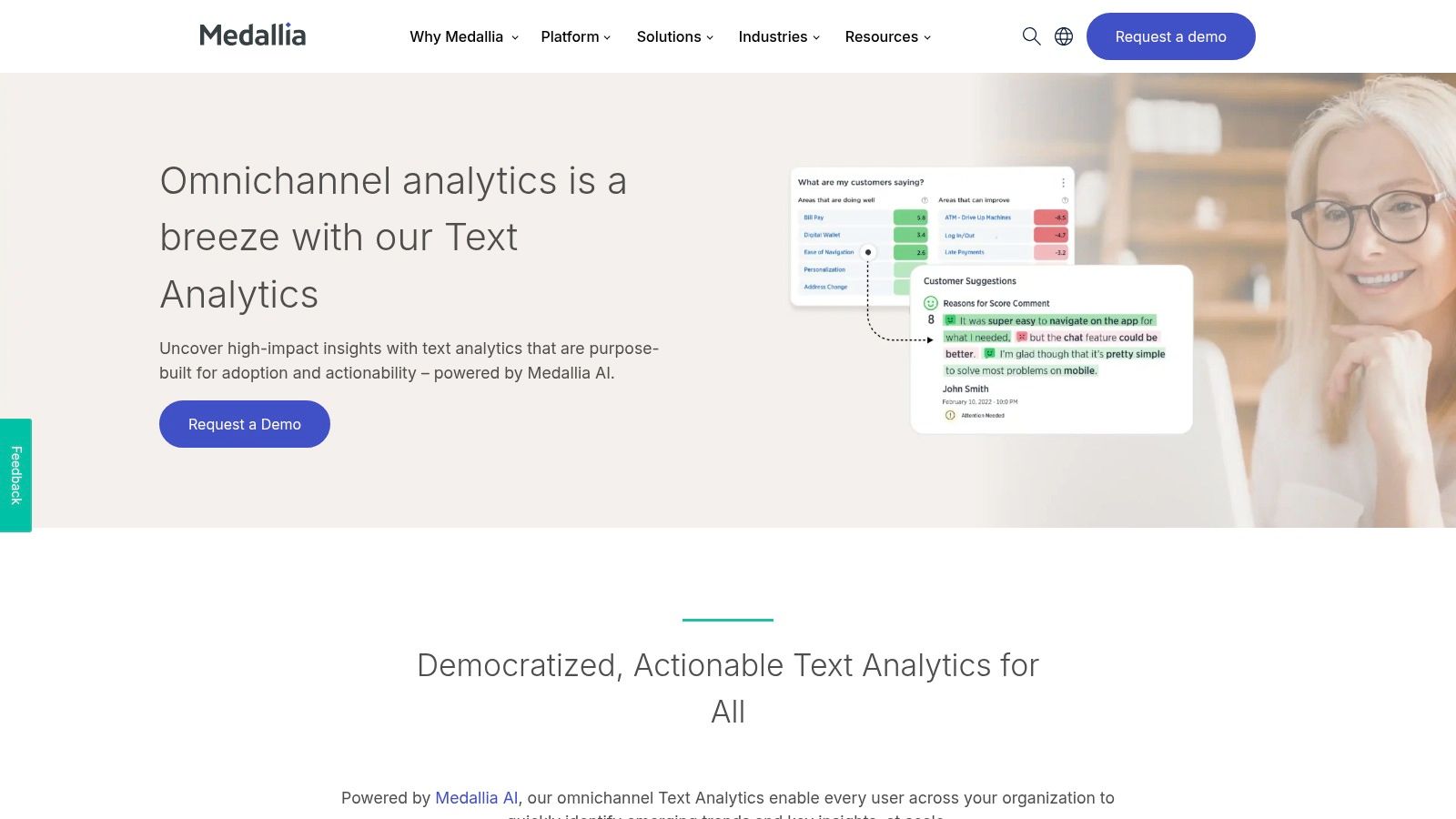
The platform’s core strength is its intuitive, visual workflow. Users can easily upload data, label it within the interface to teach the model, and then visualize the results in a central dashboard. MonkeyLearn Studio allows you to connect different models together into a cohesive analysis workflow, turning raw feedback from sources like support tickets or NPS surveys into organized, quantifiable data points.
Key Features and Considerations
Integrations with tools like Zapier, Google Sheets, and Zendesk allow for seamless automation, automatically analyzing new text as it comes in.
- Best For: Customer support, marketing, and product teams who need to analyze large volumes of qualitative customer feedback to identify trends, tag support tickets, or track brand sentiment.
- Pricing: The pricing structure is not fully transparent on the website, with Studio plans often requiring a sales consultation. Publicly referenced API plans start around $299 per month, which may be a significant investment for smaller teams.
- Highly business-friendly UI designed for non-technical users.
- Excellent for customer support automation and feedback analysis.
- Strong integration capabilities for building automated workflows.
- Pricing is not publicly listed and can be sales-led.
- Narrowly focused on NLP and text analysis, not a general-purpose ML platform.
Visit the website: https://monkeylearn.com
12. Teachable Machine by Google
Teachable Machine is a web-based tool from Google that makes creating machine learning models fast, easy, and accessible to everyone. It stands out as one of the simplest no-code AI platforms by allowing users to train a custom model directly in their browser without any setup or prior expertise. You can train a computer to recognize your own images, sounds, and poses in minutes, making it an exceptional tool for rapid prototyping, interactive art projects, and educational purposes.

The platform’s core strength is its frictionless user experience. You simply gather and group your examples into different classes, such as training an image model to distinguish between different types of recyclable materials using your webcam. Once trained, the model can be exported with one click for use in websites, apps, and other projects using popular formats like TensorFlow.js and TensorFlow Lite. This approach demystifies AI development for beginners and creators.
Key Features and Considerations
Its completely browser-based nature means there is nothing to install, and projects can be started immediately. The models you create can be downloaded or saved to your Google Drive.
- Best For: Students, educators, artists, and developers who need to quickly build and test a proof-of-concept classification model for interactive projects without writing any machine learning code.
- Pricing: Completely free to use. There are no hidden costs, accounts, or credit card requirements to start building and exporting models.
- Extremely user-friendly interface perfect for beginners.
- No cost, setup, or installation required.
- Fast training and instant feedback directly in the browser.
- Limited to simple image, audio, and pose classification tasks.
- Not suitable for production-grade or large-scale commercial applications.
Visit the website: https://teachablemachine.withgoogle.com
No-Code AI Platforms Feature Comparison
Choosing the Right No-Code AI Platform for Your Needs
The journey into artificial intelligence no longer requires a degree in data science or years of coding experience. The diverse array of no-code AI platforms we have explored demonstrates that powerful predictive modeling, natural language processing, and data analysis are accessible to teams of all sizes and skill levels. Your primary challenge is not building the technology but selecting the right tool for the job.
The ideal platform choice is a direct reflection of your specific business goals, existing technical infrastructure, and available budget. A one-size-fits-all solution simply does not exist in this dynamic market.
A Practical Framework for Your Decision
Making the right choice starts with a clear-eyed assessment of your needs. Before committing to a platform, work through these important questions to narrow down the options and align your selection with your strategic objectives.
- What is my primary business problem? Are you trying to reduce customer churn by analyzing feedback, predict sales trends, automate text classification, or build a simple image recognition model for a prototype? A platform like Surva.ai is purpose-built for user feedback analysis, while Akkio excels at fast predictive modeling for marketing. Define the problem first.
- What is my team's skill level? Be honest about your team's technical comfort. Platforms like Teachable Machine or MonkeyLearn offer a very gentle learning curve, perfect for absolute beginners. In contrast, tools like Dataiku or H2O.ai Driverless AI, while still no-code, provide a deeper level of customization that may better suit teams with some data literacy.
- Where does my data live? Your existing tech stack is a major factor. If your organization is heavily invested in the Google Cloud, Microsoft Azure, or AWS ecosystems, leveraging their native no-code AI platforms (Vertex AI, AI Builder, and SageMaker Canvas, respectively) is a logical choice. These tools offer seamless integration, unified billing, and robust security, which simplifies implementation significantly.
- What is my budget and expected ROI? Pricing models vary from free, open-source options like Hugging Face AutoTrain to sophisticated, enterprise-grade platforms like DataRobot. Calculate the potential return on investment. A subscription may seem costly, but if it helps you retain even a few high-value customers, it could pay for itself many times over.
Implementation and Long-Term Success
Once you have selected a tool, successful implementation depends on more than just the technology. It requires a strategic mindset. Start with a small, well-defined pilot project to prove value and build momentum. For example, instead of trying to overhaul your entire customer support system, you could begin by automating the tagging of incoming support tickets. When considering specific applications for no-code AI, exploring the top platforms for chatbots can offer valuable insights into practical implementations and user engagement strategies.
Remember that no-code AI platforms are not magic wands; they are powerful accelerators. The quality of your output is directly tied to the quality of your input data. Invest time in cleaning, organizing, and understanding your data before feeding it into any model. This foundational work is the key to generating reliable and actionable insights that drive real business growth.
The democratization of AI is here. By carefully evaluating your needs and selecting the right tool, you can unlock new efficiencies, discover hidden opportunities in your data, and build a more intelligent, responsive organization without writing a single line of code. The power is truly in your hands.
Ready to turn your customer feedback into a powerful retention engine? Surva.ai is a specialized no-code AI platform designed for SaaS teams to analyze user feedback, identify churn risks, and build a better product. Start your journey toward data-driven decisions at Surva.ai.


